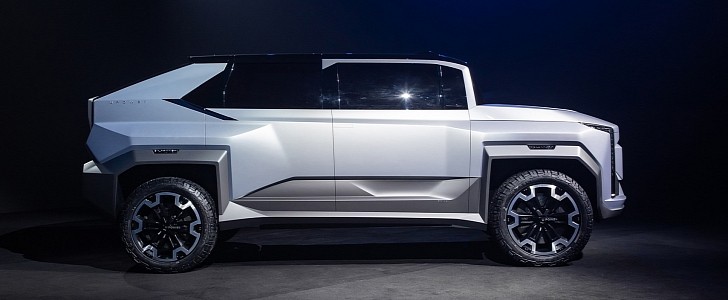There was a time Chinese car companies were often accused of copying famous Western automakers’ designs. That is not that far behind us: just check the Ora Punk Cat and try not to mistake it for larger and electric Volkswagen Beetle. However, we may be facing a time in which Western companies also copy original designs from their Chinese competitors. That seems to be the case with the Citroën oli and the UPower SUV.
The first person to notice the resemblance was the journalist Greg Kable. He asked in a tweet who did it better: UPower or Citroën. We let that to our readers to decide. What we can say is who did it first: UPower presented its SUV in January 2022. In fact, it presented five vehicles and its Super Board, an electric frame that underpins all five models. One of them was the SUV.
While the designs of the Citroen concept and that of the UPower SUV are pretty similar, the vehicles follow very different concepts. The oli was created to be lightweight and affordable, while the UPower SUV did not seem to have any purpose other than showing how versatile the UPower Super Board was.
According to the Chinese company, this electric frame will allow the vehicles based on it to have a range of 1,000 kilometers (621 miles) and offer 1,000 trillion or tera operations per second (TOPS) of computing power. As a comparison, the NIO ES7 gets 1,056 TOPS, and the Tesla Model 3 has only 144 TOPS.
UPower did not mention how light the SUV or even only the Super Board was. With a ranger of 1,000 km, it would have to offer at least a 100-kWh battery pack if it had the same energy consumption as the oli (10 kWh/100 km or 6.2 mi/kWh). The larger battery pack alone would certainly make that number higher.
Unlike the UPower SUV, the oli has a bed in the back that can be expanded with a midgate. The Chinese vehicle is more conventional in that as well as in the front doors, bumpers and other identical components that the oli presents. The UPower SUV gets unique components for each side of its sides.
As different as these concept cars are in essence, their striking styling resemblances make them an interesting pair: same shapes, very different propositions.
While the designs of the Citroen concept and that of the UPower SUV are pretty similar, the vehicles follow very different concepts. The oli was created to be lightweight and affordable, while the UPower SUV did not seem to have any purpose other than showing how versatile the UPower Super Board was.
According to the Chinese company, this electric frame will allow the vehicles based on it to have a range of 1,000 kilometers (621 miles) and offer 1,000 trillion or tera operations per second (TOPS) of computing power. As a comparison, the NIO ES7 gets 1,056 TOPS, and the Tesla Model 3 has only 144 TOPS.
UPower did not mention how light the SUV or even only the Super Board was. With a ranger of 1,000 km, it would have to offer at least a 100-kWh battery pack if it had the same energy consumption as the oli (10 kWh/100 km or 6.2 mi/kWh). The larger battery pack alone would certainly make that number higher.
Unlike the UPower SUV, the oli has a bed in the back that can be expanded with a midgate. The Chinese vehicle is more conventional in that as well as in the front doors, bumpers and other identical components that the oli presents. The UPower SUV gets unique components for each side of its sides.
As different as these concept cars are in essence, their striking styling resemblances make them an interesting pair: same shapes, very different propositions.
Who did it better?
— Greg Kable (@GregKable) September 29, 2022
UPower or Citroen? pic.twitter.com/dttfZcvhQh
















